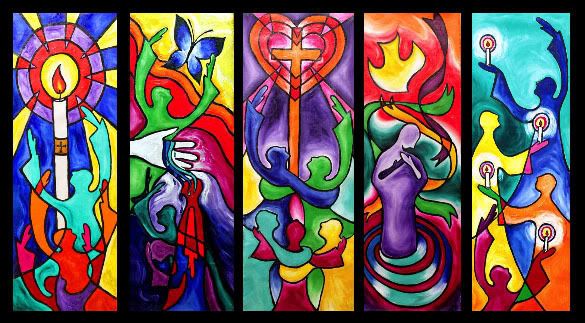A SERMON FOR THE 4TH SUNDAY IN LENT
MARCH 11, 2018
Numbers 21:4-9
John 3:14-21
We start out with a bizarre story from Numbers. What’s your favorite Old Testament story? You could probably name quite a few and my guess is that this one isn’t among them. It certainly wouldn’t make your top ten list. Maybe not even your top thousand. But here it is.
MARCH 11, 2018
Numbers 21:4-9
John 3:14-21
Today is the fourth Sunday in Lent. The ancient church gave this day a name: Laetare (lay-TAR-ee). It comes from the Latin word “rejoice.” Here we are in the middle of Lent—a church season so somber we don’t even get to sing the Alleluia verse—and yet today is Laetare, the day of rejoicing. In the early church the prayers for this day all began with the word “rejoice”. Now this may seem odd but the happiness was about the fact that we’ve passed the halfway point now so Easter is closer than Ash Wednesday! Woo hoo! The resurrection is almost here! That’s why today’s scripture lessons are filled with joy.
Or are they? They don’t necessarily seem like it. But I assure you, they were chosen to support the rejoicing theme for Laetare. So let’s explore them to uncover what truths therein might just cause us to rejoice.
We start out with a bizarre story from Numbers. What’s your favorite Old Testament story? You could probably name quite a few and my guess is that this one isn’t among them. It certainly wouldn’t make your top ten list. Maybe not even your top thousand. But here it is.
It happens in the midst of the Exodus. The Hebrew people have been liberated from slavery and they’re on their way to the sweet freedom of the Promised Land. But let’s be honest: after years in the dusty desert the road trip has kind of lost its fun. They’re like little kids in the back seat whining: “Are we there yet?” They get mad at Moses and cry to him: “Why have you brought us up out of Egypt to die in the wilderness? There is no food and no water, and besides we hate this food.” Wait. How can the food be bad? I thought you said you didn’t have any. I guess manna doesn’t count as food because it’s so gross to them at this point. In any case, they are grouchy about the whole situation (and we can hardly blame them—I don’t think any of us would tolerate a 40-year road trip on foot). Then along comes a herd of serpents or whatever it is you call a whole bunch of snakes that bite and kill people. The text calls them seraphim snakes but could also be translated: “fiery monster snakes.” Yikes! The people assume the arrival of these horror-movie-style serpents is God’s punishment for their complaining.
Divine wrath and savage snakes with big, pointy teeth? Um…this doesn’t sound like a rejoicing story. The people of God don’t think it does either so they beg for help and guess what? There is mercy for them. God tells Moses to make a bronze snake—just like the ones biting them—mount it high up on a pole and carry it through the camp telling people who have been bit to look up at it. Add sculptor to Moses’ job description because he follows this instructive and sure enough, when the bitten look at it, they are healed. A great grace is given to the grumblers. It offers us a glimpse of God’s mercy. Cause for rejoicing? Yes! Still, it’s a snake story so you can see why it never gained the popularity of other Old Testament narratives.
Then, in the gospel lesson from John, we come in on the middle of a midnight conversation Jesus is having with a religious leader named Nicodemus. Jesus is trying to get through to this man that God is offering a new covenant through him. He says, “And just as Moses lifted up the serpent in the wilderness, so must the Son of Man be lifted up, that whoever believes in him may have eternal life.” See? He is making reference to the Exodus story we just heard. In the same way that God provided miraculous healing for the people through the snake sculpture, God is now providing healing from the burden of sin through Jesus who will be soon lifted up on the cross to pour out his life for all people.
Then, comes John 3:16, the verse that everyone knows. “For God so loved the world that he gave his only begotten Son, so that everyone who believes in him may not perish but may have eternal life.” It is known as the “gospel in a nutshell”. Millions have memorized it, most misunderstand it. Have you noticed how often it is used to exclude or condemn people for not properly believing in Jesus? Once I saw the Rolling Stones in concert and one of the protesters outside the stadium was holding a sign that had John 3:16 on it. Seriously? I’m going to perish because I came to see the Stones?
But this verse is not about condemnation. It’s quite the opposite. Listen to what Jesus says next: “Indeed, God did not send the Son into the world to condemn the world, but in order that the world might be saved through him.”
John wants us to contemplate the power of what Jesus did on the cross. In this self-sacrificial act he offers God’s redemptive love to the whole world. This is grace in its most obvious form. And when we lift this message up, it is so incredible that it draws people in—not because of guilt but because of genuine love.
Love is the theme that dominates John’s entire gospel. We hear that God is love (1 Jn. 4:8), that the relationship between Jesus and his Father is love (Jn. 15:9-10; 17:23), and that the nature of discipleship is love (Jn. 13:34-35; 15:12-14).
Like the serpent lifted up by Moses, the love of God in Christ is healing. Even more that that: it saves. That is why they call John 3:16 the gospel in a nutshell: For God so loved the world that he gave his only Son, so that everyone who believes in him may not perish but may have eternal life.
Saving love. Offered to everyone. Okay, maybe that is cause for rejoicing.
Nicodemus doesn’t quite know how to react to this message. He’s still metaphorically in darkness. His people—the religious authorities—are concerned about Jesus and his bold reinterpretations of their teachings. That’s presumably why he’s had to sneak off and have this conversation with Jesus at night. Now Jesus tells him he must be born again and live a whole new life of love. That’s an overwhelming request. It takes Nicodemus a while to come around and embrace that challenge.
What about you and me? How do we respond to the challenge? How do we let go of our old lives, our old priorities and be born anew in Christ? How do we really live in that loving way—not just believing in Jesus but continuing his work?
As I contemplated this question, I was offered a burst of inspiration. On Thursday, Luther College hosted a distinguished lecturer named Daryl Davis. A musician and author, Daryl has formed lasting friendships with a large number of people in the Ku Klux Klan. This might not sound so amazing if you didn’t know that Daryl is black. That’s right: a black man had the courage to talk with people who wanted to kill him. Not only that, he formed such transformative relationships with them that over 200 of them have renounced their old lives in the hate group and literally handed over their Klan robes to Daryl. His collection of them continues to grow and he’s proud of them because each one symbolizes a life changed.
 |
| William Gentry, Daryl Davis, Laura Gentry |
William and I went to Daryl’s lecture and were riveted by his simple message. He explained to the crowd that he’s no psychologist or anyone with special training in human nature. He’s just a musician with a curiosity. He wanted to understand these Klans-people even though they were dangerous and hated him. And by engaging in dialogue with his enemies without defensiveness or judgement, he's been able to change them. You could say that they have been born again.
It seems to me that’s exactly what Jesus is calling us to do here. What should we to do with the grace given to us? Like John the Baptist, we are to bear witness to the light. With our very presence we are to be Good News for all people.
Today is Laetare—a day of rejoicing. How will you respond to this message of joy? Maybe you don’t want to do anything. You just want to head straight to brunch and forget all about this difficult challenge you’ve been offered. And that’s understandable. Brunch is good.
On the other hand, you might want to consider what it would be like to take the call seriously. You. Out there sharing God’s love with people. You. Crossing bridges to connect with people you might even consider enemies because you are different races or you have different ideologies or political views. You. Being the vehicle of God’s healing grace. Wouldn’t that be the makings of “eternal life” here on earth?
I think it’d be pretty cool. It’s not impossible. Daryl Davis says if he can build bridges with the Klan then all human connections are possible. With simple acts of kindness and deep listening, friendships can develop that transform people and transform the world. Just contemplating this opportunity should cause our hearts to rejoice.
You want to really celebrate Laetare? Then I’ll give you a special challenge. Your mission, should you choose to accept it, is this: Sometime this week, forge a new connection with someone who is different than you are. If you want to go for the top level challenge to get extra credit points find a person who hates you and talk with them. Seek to understand them. Inch your way into an actual friendship. That’s what discipleship is all about and you’ve got the grace to do it. Go shine your light. Amen.
© 2018 Laura E. Gentry








